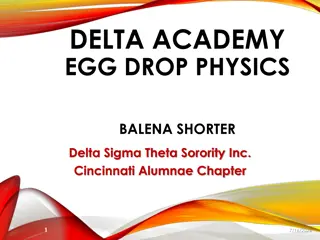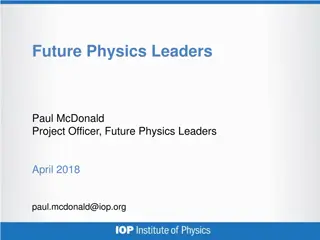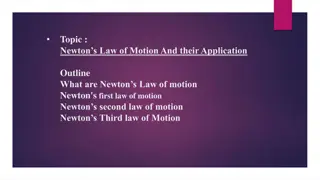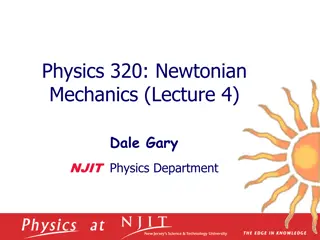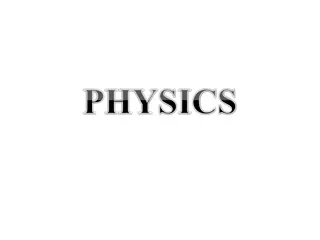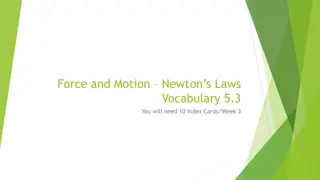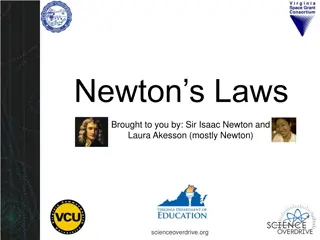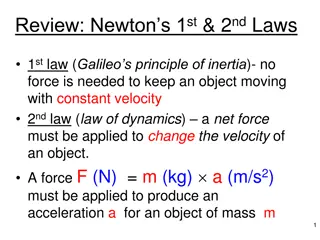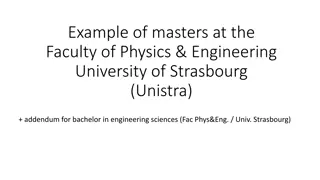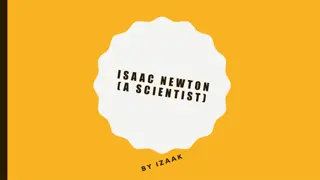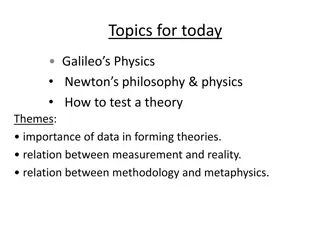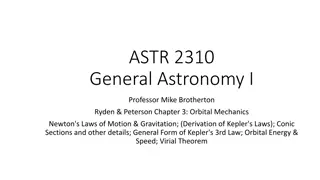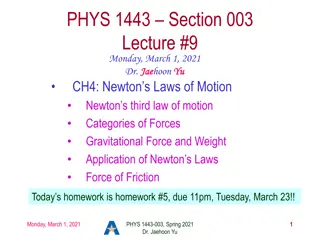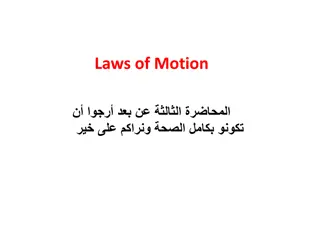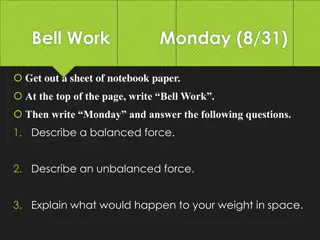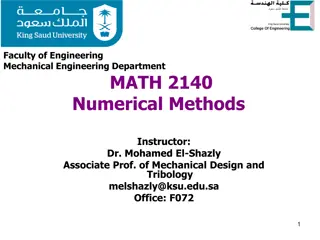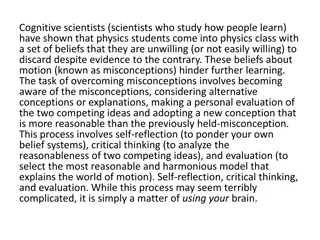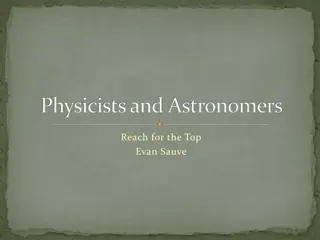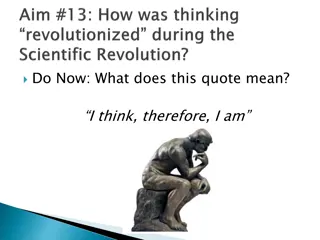Physics Misconceptions and Newton's Laws
Cognitive scientists have shown that physics students often hold misconceptions about motion that hinder their learning. Overcoming these misconceptions involves self-reflection, critical thinking, and evaluation. Newton's laws of motion play a significant role in understanding the concepts. Questions regarding force, motion, and Newton's first law are explored to enhance comprehension of physics principles.
Download Presentation

Please find below an Image/Link to download the presentation.
The content on the website is provided AS IS for your information and personal use only. It may not be sold, licensed, or shared on other websites without obtaining consent from the author.If you encounter any issues during the download, it is possible that the publisher has removed the file from their server.
You are allowed to download the files provided on this website for personal or commercial use, subject to the condition that they are used lawfully. All files are the property of their respective owners.
The content on the website is provided AS IS for your information and personal use only. It may not be sold, licensed, or shared on other websites without obtaining consent from the author.
E N D
Presentation Transcript
Cognitive scientists (scientists who study how people learn) have shown that physics students come into physics class with a set of beliefs that they are unwilling (or not easily willing) to discard despite evidence to the contrary. These beliefs about motion (known as misconceptions) hinder further learning. The task of overcoming misconceptions involves becoming aware of the misconceptions, considering alternative conceptions or explanations, making a personal evaluation of the two competing ideas and adopting a new conception that is more reasonable than the previously held-misconception. This process involves self-reflection (to ponder your own belief systems), critical thinking (to analyze the reasonableness of two competing ideas), and evaluation (to select the most reasonable and harmonious model that explains the world of motion). Self-reflection, critical thinking, and evaluation. While this process may seem terribly complicated, it is simply a matter of using your brain.
Newtons Laws FORCE AND MOTION acceleration
What do you think? An object s ________ is most closely linked to the size of the net (vector sum) force acting on an object. a) position b) displacement c) velocity d) acceleration An object will move at a constant velocity if: a) a constant net force acts b) no net force acts To make an object move to the right and speed up the same amount each second requires a net force that is
What do you think? Imagine a place in the cosmos far from all gravitational and frictional influences. Imagine that you visit that place and throw a rock. The rock will: a. gradually stop. b. continue in motion in the same direction at constant speed. c. This prediction cannot be made
What do you think? Supposing you were in space in a weightless environment, would it require a force to set an object in motion?
Newtons 1stLaw An object at rest will remain at rest, and an object in motion will remain in motion at a _ _ _ _ _ _ _ _ _ _ _ _ _ _ _ _ unless it is acted upon by a _ _ _ force. If If then then
Newtons 1stLaw An object at rest will remain at rest, and an object in motion will remain in motion at a CONSTANT VELOCITY unless it is acted upon by a NET (external) force. If F = 0 If F 0 then a=0 then a 0 (acceleration occurs)
Newtons 1stLaw CYU Cars had no seatbelts in the 1950 s. Then, if a car ran into a rigid obstruction (like a tree) the passengers . A) were thrown forward. B) continued forward. C) were thrown backward.
Newtons 1stLaw CYU In a head on collision, the job of the seatbelt is to A) balance the forces on the passenger. B) exert an unbalanced force on the passenger, toward the back of the car. C) exert an unbalanced force on the passenger toward the front of the car.
The job of a head rest: A head rest does its job when a car is struck from behind. In this type of accident, the headrest must: a) Balance the forces on the person s head to b) Exert a net force on the person s head toward the front of the car to c) Exert a net force on the person s head toward the rear of the car to
So, a (net) force is the cause of ACCELERATION
What is the mathematical relationship between _______________( ) and ____________( )?
What is the mathematical relationship between an object s acceleration (m/s/s ) and the net force (N) acting on it? (Assume _ _ _ _ is kept constant.)
What is the mathematical relationship between an object s acceleration (m/s/s ) and the net force (N) acting on it? (Assume MASS is kept constant.)
Newtons 1stLaw, also called The Law of
Newtons 1stLaw, also called The Law of INERTIA
Inertia! What is it? Can it be measured? Does it have units?
Mass is NOT: weight a force a vector volume
The Inertial Balance What does it measure? Where can it be used?
So, mass is the measure of______________________ Doesn t that mean mass affects acceleration? Can you ask: What is the mathematical relationship between _________________________ (_____) and mass (kg) of an object?
What is the mathematical relationship between an object s acceleration (m/s/s ) and its total mass (kg)? (Assuming the is kept constant.)
What is the mathematical relationship between an object s acceleration (m/s/s ) and its total mass (kg)? (Assuming the net force is kept constant.)
Now you (should) understand how Net Force and Mass affect Acceleration Net force is the cause of acceleration. The resulting acceleration is in the direction of the net force. A greater net force causes a greater acceleration. In fact, twice the net force causes twice the acceleration, as long as the _________ is kept constant. Mass is the measure of the resistance to acceleration. A more massive object will accelerate less quickly from a net force than a less massive object. In fact, an object that is twice as massive will accelerate half as quickly given the same ___ _________. a = F/m (Newton s 2ndLaw!)
Newtons 2ndLaw Relates net force, mass, acceleration acceleration = net force / mass a= F/m F=ma a=Fnet/m NOTE: This law focuses on the net force on ONE object and the resulting acceleration of that ONE object.
Ex: Basic Applications of Newtons 2nd Law A Tesla S has a mass of 2107kg. What net force is required to accelerate this car to 100 km/hr in 2.36 seconds? Dennis (67kg) can start from rest and sprint 10.0m in 2.58 seconds. How much (average) net force does this require? A major league pitch can impact the catcher s glove. The ball is stopped after moving 20.0cm. If the 142g ball is acted upon by a net force of 7000N (from the glove) acting on it during the collision., how fast was it moving? (Assume the ball slows with a uniform acceleration.)
A Net Force is The VECTOR SUM of ALL of the forces acting on an object.
What is a Force? Symbol? SI unit? Definition? Examples? (types of individual forces)
Types of Forces Type Agent (Fg) Gravitational force (Fn) Normal force (Ff) Friction (force) (Fa) Applied force (Ft) Tension (force) (Fd) Drag (force) (Fthrust) Thrust (Flift) Lift (force)
Types of Forces Which force is always present for earth-bound objects? Upon what does it depend?
What is the mathematical relationship between .
What is the mathematical relationship between . an object s weight in newtons (or the force of gravity on it) and its mass in kilograms? This is the question we d like to answer, but
What is the mathematical relationship between . the magnitude of the force needed to counter the gravitational force (N) on an object and the mass (kg) of the object? This is the actual question we will answer. Why is there a difference?
Weight Weight is defined differently in various texts. Some say weight is another name for the force of (or due to) gravity. Some say weight is the force needed to counter the force of gravity to keep an object from accelerating vertically. How does one force keep an object from accelerating vertically? In other words, what does counter mean?
Weight The force of gravity is the force with which the earth, moon, or other massively large object attracts another object towards itself. By definition, this is the weight of the object. All objects upon earth experience a force of gravity that is directed "downward" towards the center of the earth. the PCR
Weight We will say that weight is the size of the gravitational force on an object. Weight is directly proportional to mass. Fg= mg Fg= weight, or gravitational force (in newtons) m = mass (in kilograms) g = acceleration due to gravity, OR free fall acceleration, on earth 9.8m/s/s OR gravitational field strength (9.8 N/kg) Weight changes with location in the universe.
Practice What is the weight (in N) of a 30 kg suitcase? (if it is on earth) An astronaut weighs 700N on Earth. How much does he weigh on the moon (where g=1.6 N/kg)?
Assignment: Honors Physics Read PCR Newton s Laws Lessons 1,2 Complete Quest: Mass, Weight, Force
Types of Forces (a second look) Type Agent (Fg) Gravitational force (Fn) Normal force (Ff) Friction (force) (Fa) Applied force (Ft) Tension (force) (Fd) Drag (force) (Fthrust) Thrust (Flift) Lift (force)
What is net force? The vector sum of all the forces acting on an object and it is the cause of acceleration.
What is a NET FORCE? It is NOT a type or example of a force. It is the VECTOR sum of all the forces (acting on an object). It is also called the unbalanced force, the sum of the forces, and total force. Symbols: F (or just F by lazy teachers and authors) or Fnet
I am still confused, I cant visualize forces! Force cannot be seen! Many forces can be felt, but only by the objects that are interacting. We construct Free Body Diagrams (FBD) to assist us. 1. Draw a dot or small box to represent the object 2. Draw one arrow representing each of the forces acting on the object. Draw the arrow in the direction of the force. Make the arrow longer for a stronger force. 3. Label each arrow with an F and subscript.
Which FBD is for an object that is NOT MOVING? accelerating!?
Free Body Assignment Teacher does one example Students complete all 12 on PCR In notes, copy the problem description, the labeled FBD (be sure it is drawn to scale) FOR EACH PROBLEM YOU DIDN T GET ON THE FIRST TRY.
Assignment - Read PCR Newton s Laws Lessons 2c,d, 3a,b - Start Quest Newton s2nd and 3rdLaws
What about the forces between two objects? Newton s 1stLaw uses forces to determine if an object _ _ _ _ _ _ _ _ _ _ _ Newton s 2ndLaw relates the acceleration to the net force and mass MATHEMATICALLY Newton s Third Law focuses on the size and directions of the forces that are applied when tow objects interact. It does NOT analyze the movement that results form the forces!



